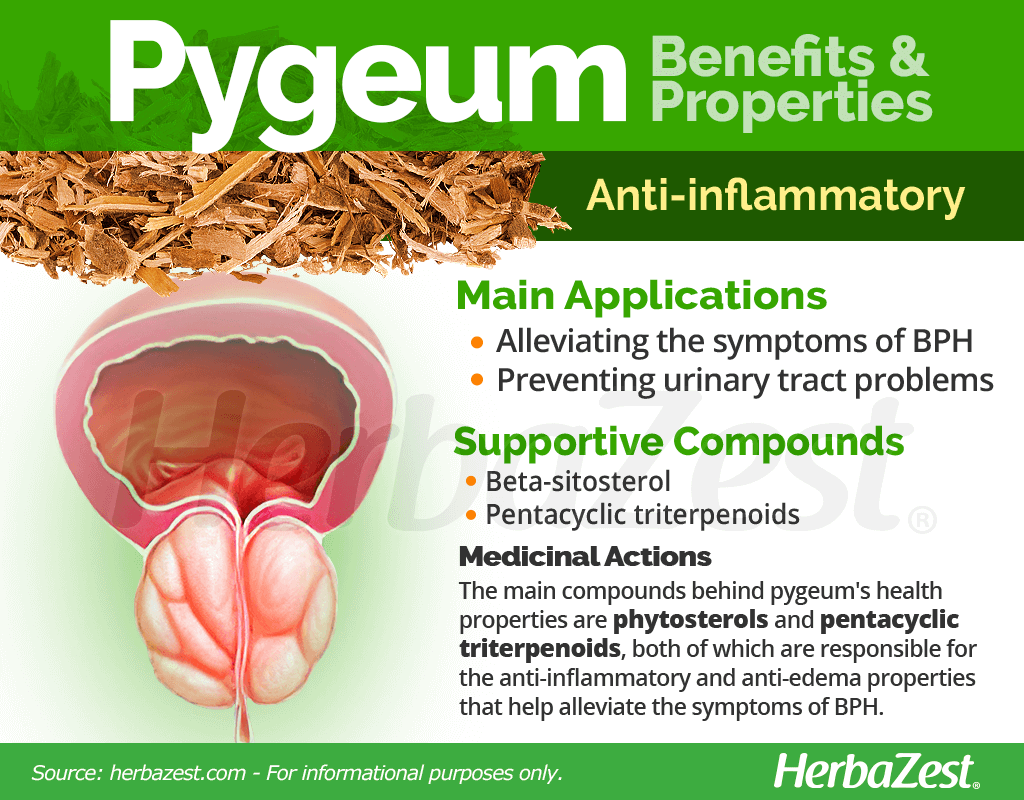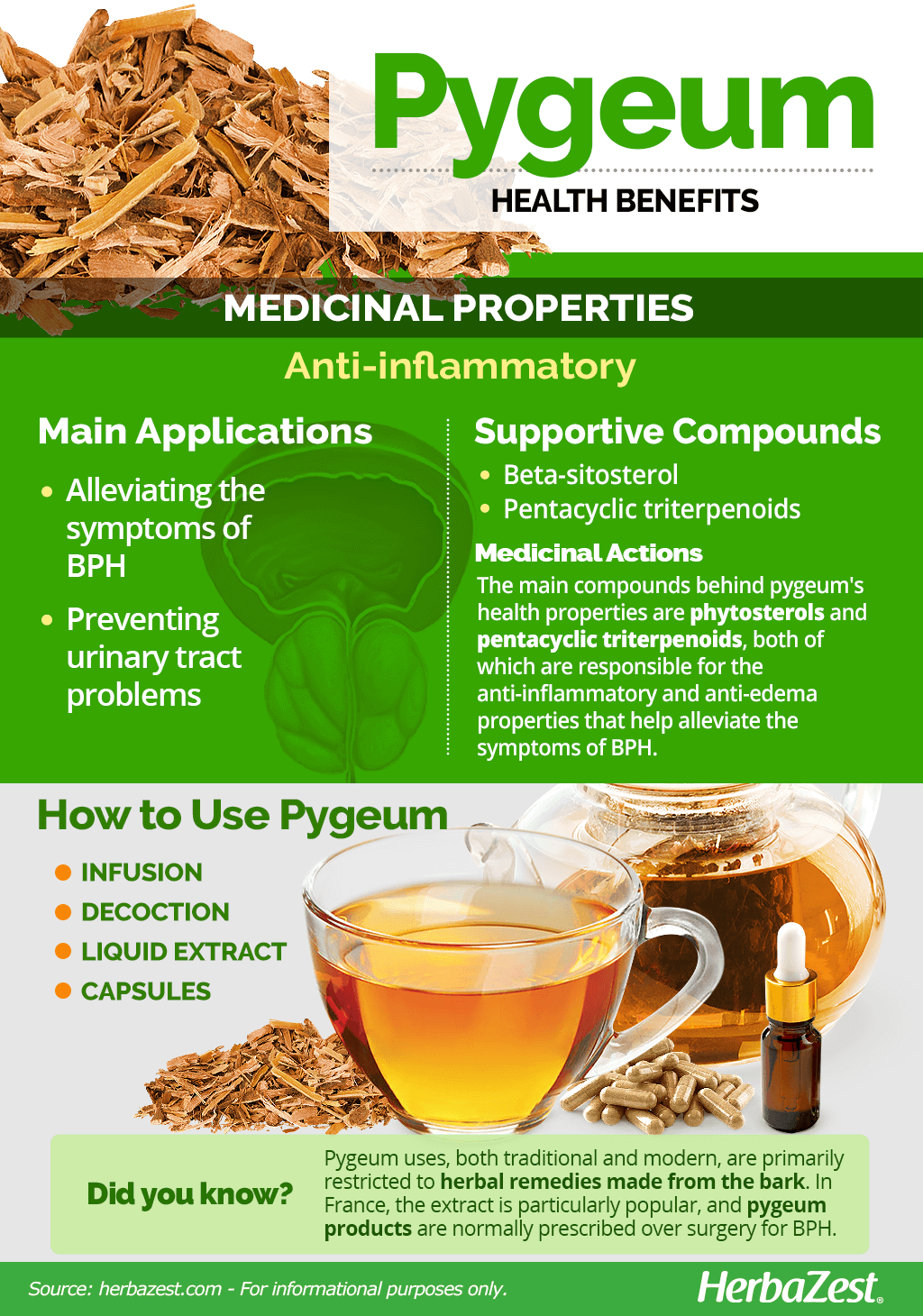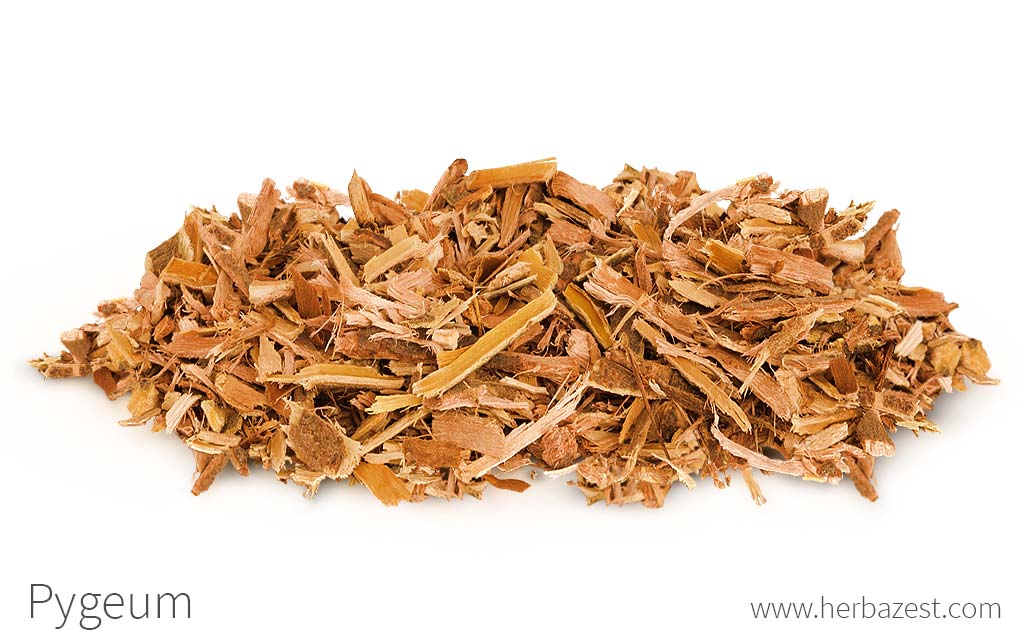Pygeum has been recognized in its native Africa for many centuries, owing to its immense medicinal value. It has only somewhat recently been discovered by Europe and is now a popular medicinal herb in the region.
Pygeum Medicinal Properties
Health Benefits of Pygeum
The anti-inflammatory properties of pygeum have been used in traditional African medicine for centuries as a remedy for a variety of health conditions. However, scientific research have validated some folk uses of the herb, mainly:
Alleviating the symptoms of BPH. modern uses of the plant mainly focus on its effectiveness at reducing the symptoms of benign prostatic hyperplasia (BPH), which is the medical term for the non-cancerous enlargement of the prostate.
Preventing urinary tract problems. Due to its anti-inflammatory properties, pygeum is often taken as a supplement for urinary tract health support.
How It Works
The main compounds behind pygeum's health properties are phytosterols and pentacyclic triterpenoids. These are responsible for the anti-inflammatory and anti-edema properties that are thought to be the main reasons this plant is used for curing the symptoms of BPH.1
Significant compounds that contribute to the benefits of pygeum are tannins, amygdalin, and cyanogenic glycoside.
Pygeum's phytosterol beta-sitosterol is found in various plants and works by hindering the synthesis of prostaglandins, thus resulting in reduced inflammation. Studies have shown lower levels of prostaglandins in BPH patients who have been administered beta-sitosterol. The pentacyclic triterpenoids also help prevent inflammation by obstructing activity of the enzymes. They are effective anti-edema agents and also help increase the integrity of small veins and capillaries.
Other anti-inflammatory herbs that reduce edema and are beneficial for prostate health are saw palmetto and nettle.
Pygeum Side Effects
The medicinal use of the herb is commonly regarded as generally safe, although some men may experience some mild pygeum side effects, such as stomach upset, nausea, and diarrhea.
Cautions
Pygeum has not been reported to interact with any other medication or supplement. It is commonly taken in combination with saw palmetto for the treatment of benign prostatic hyperplasia; however, overharvesting has put pygeum on the verge of becoming an endangered species. Nowadays, herbalist recommend the use of pygeum only when other herbs haven't worked.
Pygeum is rarely taken by women; there are no data of its effects during pregnancy and lactation.
- Medicinal action Anti-inflammatory
- Key constituents Beta-sitosterol, pentacyclic triterpenoids
- Ways to use Capsules, Decoctions, Hot infusions/tisanes, Liquid extracts
- Medicinal rating (2) Minorly useful plant
- Safety ranking Safe

How to Consume Pygeum
Pygeum uses, both traditional and modern, are primarily restricted to herbal remedies made from the bark. Aside from the berries of the pygeum tree being eaten by gorillas and some birds, there is virtually no culinary applications for pygeum.
Natural Forms
- Infusion. The dried pygeum bark can be stepped in hot water for few minutes. This preparation can be taken on daily basis for treating urinary problems and promoting prostate health.
Decoction. A concentrated preparation is obtained by boiling the pygeum bark with water. This liquid can be taken every day to reap the anti-inflammatory benefits of the herb.
Herbal Remedies & Supplements
Liquid extract. strong preparation concentrates all the medicinal pygeum benefits. Few drops of pygeum extract diluted in a glass of water can have a potent anti-inflammatory effect.
Capsules. In this supplemental form, pygeum can be taken every day, in standardized doses, for a more controlled anti-inflammatory action and urinary tract health support.
- Edible parts Inner bark
- Taste Bitter

Growing
Pygeum trees are mostly confined to tropical climates, and their natural population has been damaged by overharvesting, putting this exotic species on the verge of extinction.
Growing Guidelines
- Pygeum grows best in moist environments and humid semi-highlands, at altitudes of 2625 feet (800 m) above sea level and higher.
Sandy loam soils, well-drained, moist, and nutrient-rich, are necessary for proper germination and growth of pygeum plants.
Pygeum adapts well if planted alongside coffee and cacao, which can also be harvested sooner and produce revenue until pygeum is ready to harvest.
The seeds for planting are extracted from the mature fruits by rubbing them with sand to remove the pulp.
Pygeum can also be propagated by taking leafy stem cuttings from plants with healthy and vigorous shoots.
To stimulate growth, 50 grams of a general purpose fertilizer can be applied to the soil around the pygeum tree a month after planting.
Pruning the lower branches from the trunk of saplings can facilitate later bark harvesting.
It is important to consider that it will take 15 to 25 years for pygeum trees to grow before their bark is ready to be harvested.
The fruits of the pygeum trees are commonly eaten by rats, primates, and birds.
As part of recent preservation efforts, pygeum trees have been favored as part of agroforestry programs and as an alternative for reforestation.
- Life cycle Biennial
- Growing habitat Humid regions, Tropical rainforests
- Growing time 15 years
Additional Information
Plant Biology
Pygeum is a native African evergreen tree that grows up to 120 feet (35 m). The oblong leaves are glossy and dark green in color, and have minute serrations along the edges. It bears small white flowers in elongated clusters that are then followed by reddish-brown berries, which are usually around 0.4 inches (10 mm) in diameter.
Classification
A member of the Rosaceae or rose family, pygeum is also classified into the Prunus genus, which includes innumerable species of flowering plants, some of them of great economical and medicinal value, such as apple (Malus domestica), blackberry (Rubus fruticosus), blackthorn (Prunus spinosa), cherry (Prunus spp.), and pear (Pyrus communis).
Varieties and Subspecies of Pygeum
Botanists have not identified any distinct subspecies or varieties of pygeum. The pygeum tree was previously known as Pygeum africanum, but has been re-christened Prunus africana, so information about pygeum can be found under both names.
Historical Information
The history of pygeum is mainly medicinal, with bark decoctions having been used in traditional African medicine as a cure for male health problems, including infertility, impotence, and enlarged prostate. It was not introduced to the Western herbal medicine world until the late 1800s.
Economic Data
In the last 20 years, the pygeum market has seen a massive increase, and this large-scale harvesting of trees has driven the wild plant to be classified as vulnerable - that is, to the brink of endangerment unless the circumstances around its reproduction improve considerably. The pygeum tree has been intensively farmed for the European pharmaceutical industry, and because wild pygeum is becoming rarer, a commercial farming industry has been developed for pygeum trading. In France, the bark extract is particularly popular, and pygeum products are normally prescribed over surgery for BPH.
Pygeum is nearly endangered due to its slow growth rate and extensive use in the pharmaceutical industry.
Other Uses of Pygeum
Environmental. Planting pygeum on steep slopes has become a useful practice for reforestation, as well as for reduction of soil erosion and landslides.
Ecological. The pygeum tree is an important source of pollen and nectar for bees and other insects, and its fruits are eaten by rodents, birds and mammals, many of which are only found in mountain forests.
Sources
- Biodiversity International, Ensuring the Future of the Pygeum Tree (Prunus africana)
- Columbia University, Prunus africana (Hook.f.) Kalkman
- European Commission, Prunus africana
- Evidence-based Herbal Medicine, p. 308
- Herbal Healing, p. 113
- National Geographic, More Years With Mountain Gorillas
- The Herbal Drugstore, p. 472
- Encyclopedia of Herbal Medicine, p. 259
- Encyclopedia of Natural Medicine, pp. 585, 760-761
- Medicinal Plants of the World, p. 256
- Rosemary Gladstar's Herbal Recipes for Vibrant Health, p. 358
- Germplasm Resources Information, Taxon: Prunus africana (Hook. f.) Kalkman
- New York University - Langone Medical Center, Benign Prostatic Hyperplasia ; Beta-Sitosterol
Footnotes:
- Archivos españoles de urología. (2022). Effectiveness of treatment with Pygeum africanum in patients with lower urinary tract symptoms and benign prostatic hyperplasia: a cross-sectional study in the real-world clinical practice in Spain (The PROFIT Study). Retrieved January 5, 2023, from: https://pubmed.ncbi.nlm.nih.gov/35435166/





